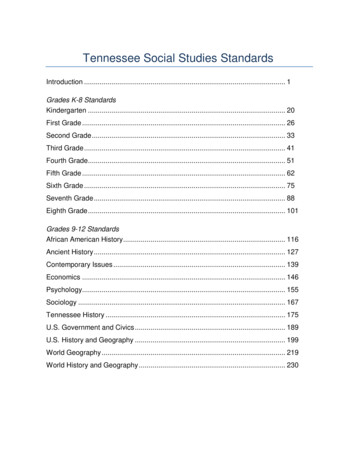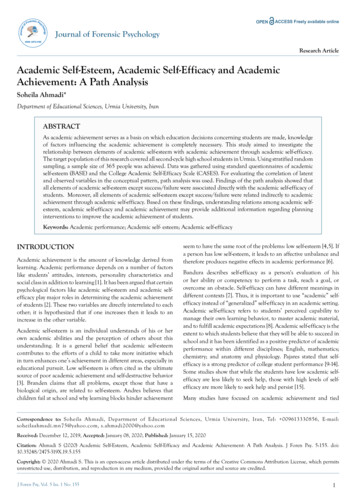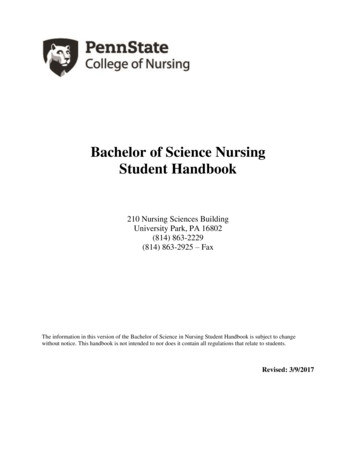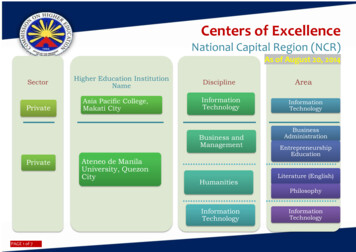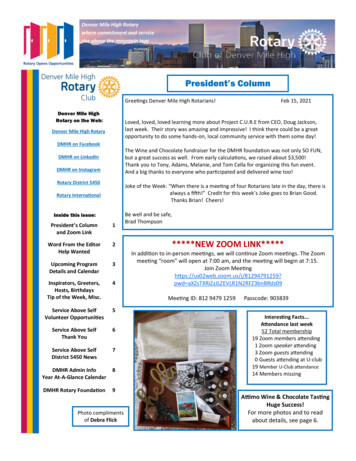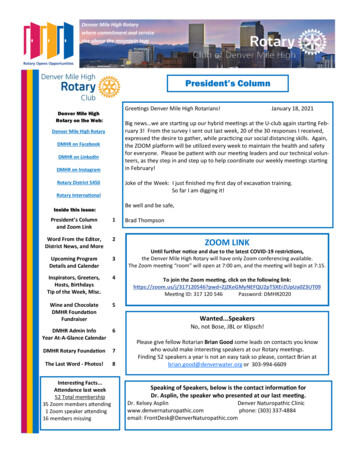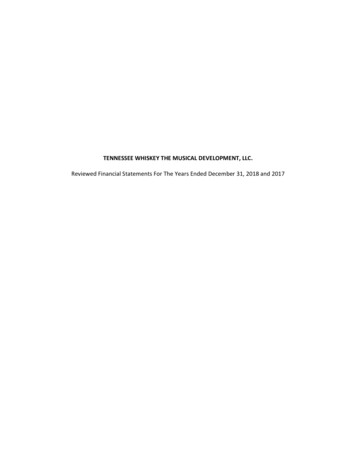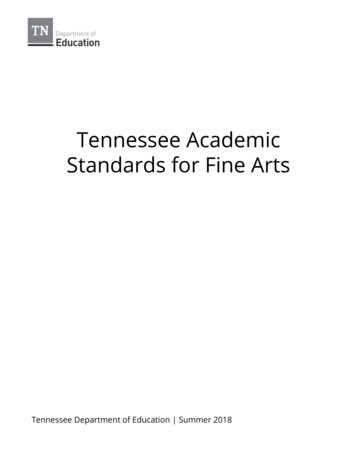
Transcription
epartmen! ofIMI. Educat1on--Tennessee AcademicStandards for Fine ArtsTennessee Department of Education Summer 2018
Tennessee Academic Standards for Fine Arts EducationIntroduction . 1DanceIntroduction to Dance and Theatre . . . 8Dance K-5 Standards. . . .11Dance 6-8 Standards. . . .28Dance 9-12 Standards. . . 45TheatreTheatre K-5 Standards. . .62Theatre 6-8 Standards . . .78Theatre 9-12 Standards. . . .91Media ArtsIntroduction to Media Arts . 106Media Arts K-12 Standards . .111Visual ArtsIntroduction to Visual Arts . 137Visual Arts K-12 Standards . .145MusicGeneral Music K-5 Standards . . .167General Music 6-8 Standards . .184General Music 9-12 Standards . 195Instrumental Music 6-8 Standards . .203Instrumental Music 9-12 Standards . 214Vocal Music 6-8 Standards .227Vocal Music 9-12 Standards . 238Music Theory 9-12 Standards . .251Music Glossary .259
Tennessee Academic Standards for Fine Arts EducationIntroductionAs states are pursuing raised standards for student learning, it is important to recognizethe essential role of arts education in the development of well-rounded studentspreparing for college, career, and life readiness. In fact, Tennessee has madesignificant artistic contributions across the national landscape, and Tennessee’s schoolteachers and leaders will undoubtedly play an important role in nurturing environmentsof creativity and innovation that will lead to even greater contributions.Tennessee Arts Education at a glanceThe federal Every Student Succeeds Act (ESSA) lists the arts and music as a part of a“well-rounded” education, and Tennessee schools offer a rich history of supporting artseducation. Tennessee is recognized nationally for significant contributions in arts andculture, and the state academic standards for arts education contribute to increasedstudent access for quality arts education that impacts college, career, and life readinessfor Tennessee students. While Tenn. Code Ann. §49-6-1025 speaks to visual art andmusic instruction for grades K-8, schools also offer courses in dance, theatre, andmedia arts instruction.(a) The course of instruction in all public schools for kindergarten through gradeeight (K-8) shall include art and music education to help each student fostercreative thinking, spatial learning, discipline, craftsmanship and the intrinsicrewards of hard work.(b) Local boards of education are encouraged to fully implement the art andmusic curriculum adopted by the board of education through both art and musicclasses, as well as integration into other core academic subjects.In addition, Tennessee graduation requirements stipulate one full credit of fine arts, andmany students elect to focus concentration on sequential course offerings in multiplearts disciplines, including visual arts, dance, media arts, theatre, and vocal andinstrumental music. As the economic development of Tennessee becomes increasinglydependent upon skills and outcomes that are embedded in the Tennessee Standardsfor Arts Education, such as critical and creative thinking, problem solving, collaboration,reflection, and persistence, it will become even more important to ensure thatTennessee students are engaged in sequential standards-based arts instruction. Artseducation can also reach a diversity of learners by embodying learning modalities,helping all students learn. For these reasons and others, it is important to consider1
several supporting factors when implementing the Tennessee Standards for ArtsEducation. The National Association for Music Education and the National Art EducationAssociation have developed National Opportunity to Learn Standards to correspond tothe implementation of standards-based arts education instruction, and local boards ofeducation are encouraged to implement the support needed to facilitate quality fine artsinstruction.2016 Revision Process OverviewThe Tennessee State Board of Education and the project leadership team partneredwith multiple arts agencies such as state arts education teachers associations, highereducation institutions, and arts education leadership councils in order to create anddisseminate a stakeholder feedback survey and recruit nominations for the writing teamapplication process. After the writing team was selected, they conducted a carefulexamination of the data from the state arts education standards feedback survey andcreated principles to guide the development of the 2016 Standards for Arts Education.The resulting standards are organized in a way that brings more unity to all of the artsdisciplines while maintaining the integrity of each specific content area. It is an attemptto bring the rich content of the previous standards to more modern understandings ofstandards so that districts can create high quality curriculum guides and students canhave the most robust arts learning possible. If implemented with fidelity, the goal of therevised standards will be to teach all students to become quality artists capable of notonly performing and creating artistic works with great fidelity, but also expressingmeaning and understanding through the arts.The next section will explain the overarching framework that houses the standards. It isimportant to note that some content areas will present the information in a differentsequence in order to bring focus to the standards. For example, you may see the“Create” domain appear first in Visual Arts while the “Perform” domain appears first formusic. This is not a mistake but an intentional presentation of the priorities for the majorwork of the content area. It is also important to note the major difference in visualpresentation between previous state standards versions and the current drafts (not infinal format versions). The previous standards were essentially a listing of 6-9(depending on the specific arts content area) statements followed by a listing ofgrade/level specific performance indicators. Eleven foundational statements consistentamong all of the arts content areas guide the updated standards, and the actualstandards that follow are content and grade/level specific. Another significantconsideration is that, depending on the particular grade and content area, not all of the11 foundations are weighted equally in terms of expected instructional time orimportance towards comprehensive artistic growth. Each content area and grade level2
will refer to the “major work of the grade” to communicate which foundations areexpected to be prioritized in order for students to gain mastery consistent with collegeand career readiness in the specific art form.Shared between all fine arts disciplines are the eleven foundations and the fouroverarching domains. The Tennessee Portfolio of Student Growth System implementedthe use of the “Perform, Create, Respond, and Connect” Domains in 2011, and the2016 Standards for Arts Education continue to group all of the revised standards insimilar domains, listed below. It is important to keep in mind that the order of thedomains will depend on each specific content area.Domains:P Perform (Music, Dance, Theatre); Present (Visual Arts) Produce; (Media Arts)Cr CreateR RespondCo ConnectAs mentioned previously, each domain has two or three “foundations” that are commonamong all fine arts disciplines, totaling eleven overarching statements of requisitebehaviors for artistic growth. Again, it is important to keep in mind that that not allfoundations are implied to be weighted equally. The weighting changes depending onthe grade and course expectations for the specific fine arts disciplines.Foundations:P Perform (Music, Dance, Theatre); Present (Visual Arts); Produce (Media Arts)1. Select, analyze, and interpret artistic work for performance/presentation/production.2. Develop and refine artistic techniques and work for performance/presentation/production.3. Convey and express meaning through the performance/presentation/productionof artistic work.Cr Create1. Generate and conceptualize artistic ideas and work.2. Organize and develop artistic ideas and work.3. Refine and complete artistic work.3
R Respond1. Perceive and analyze artistic work.2. Interpret intent and meaning in artistic work.3. Apply criteria to evaluate artistic work.Co Connect1. Synthesize and relate knowledge and personal experiences to artistic endeavors.2. Relate artistic ideas and works with societal, cultural, and historical context.A Guide to the Coding of the Updated StandardsThe standards are coded with the grade level, content area, domain, foundation, and aletter might also be used to delineate subsections of the particular foundation. Somefoundations will contain more standards than other, depending on the content and gradelevel.Examples:K.VA.P.1.A Select art objects for personal portfolio and display, explaining why theywere chosen.Kindergarten (K) is the grade, Visual Arts (VA) is the content, Present (P) is the domain,1 is the foundation “Select, analyze, and interpret artistic work for presentation”, and Ais the actual standard.6.IM.P.2.C Demonstrate musical literacy on the instrument, individually and in ensemblesettings, by adequately sight-reading a varied repertoire of music. For example:Demonstrate an understanding of basic elements associated with successful sightreading.Sixth Grade (6) is the grade, Instrumental Music (IM) is the content, Perform (P) is thedomain, 2 is the foundation “Develop and refine artistic techniques and work forperformance”, and C is the third standard under this foundation.4
Additional ConsiderationsThe following are several considerations to provide context around the revisedstandards for arts education:1. Literacy in the Arts ClassroomsLiteracy is an important concept in all academic areas. Rather than being a stand-alonesubject area, literacy provides a pathway for cognition, enabling students to learncontent efficiently and express themselves effectively. The arts, like all subject areas,help to reinforce literacy through the careful study of discipline specific vocabulary, thereview of primary sources in the content, and a variety of engagement opportunitiesspecifically in the artistic domains of “Respond” and “Connect”. However, thepredominance of Tennessee Standards for Arts Education prioritizes the principles ofartistic literacy, such as visual thinking strategies, aural literacy (audiation), and notationliteracy (decoding symbolic systems of music notation to create and interpret meaning).To the goals of college and career readiness, it would be counter productive for schoolleaders to suggest that an arts teacher limit the implementation of the TennesseeStandards for Arts Education during instructional time in order to reinforce learning inEnglish language arts classrooms. Arts teachers’ instructional efforts are best leveragedwhen creating synergy towards the multiple meanings of literacy instruction, and themultiple meanings are embedded as appropriate to each arts discipline in theTennessee Standards for Arts Education.2. Major Work of the GradeAs previously noted, the specific grade level and discipline within the arts will prioritizeinstructional time within certain foundations. Not all of the content in a givengrade/course is emphasized equally in the standards. Some foundations require greateremphasis than others based on the depth of the ideas, the time that they take to master,and/or their importance to arts learning or the demands of college and career readiness.In addition, an intense focus on the most critical material at each grade allows depth inlearning. That is not to say the other foundations are not important, only that the urgencytowards mastery does not require the same amount of instructional time dependingon the course and experience level of the young artists. For example, itmight be common in level one beginning band and orchestra to prioritize instructionaltime in foundation P2 “Develop and refine artistic techniques and work for performance”and, for example, prioritize P3 “Convey and express meaning through the performance”more heavily as the student progresses though the middle school and high schoolslevels of instrumental music. While P1 “Select, analyze, and interpret artistic work forperformance” would be covered during instruction, the relative instructional time neededto achieve the standards would not be comparable.5
3. Grade BandsWithin the Tennessee Standards for Arts Education, elementary school is defined asgrades K-5; middle school as grades 6-8; and high school as grades 9-12. It isimportant to note that in some content areas, the student point of entry is dependentupon certain factors and districts should exercise care when developing curriculummaps and course offerings. For example, to become college ready in most ensemblebased performing arts coursework, instruction should start in middle school andprogress sequentially through high school. The Tennessee Standards for ArtsEducation are constructed to reflect this common expectation.4. Opportunity to Learn StandardsThe Tennessee Standards for Arts Education are written to reflect conditions describedin the basic level programing from the National Opportunity to Learn Standards forMusic and Arts Education.6
Leaders, Writers, and Review Team MembersVisual Arts and Media ArtsHeather Casteel, Division LeadAmanda GalbraithTed EdingerJim DodsonMichelle AyersJessica RobertsKerry StacyCephas AblakwaTheatre and DanceJames Wells, Division LeadDeb PerrySarah HobbsAaron MillerLynnea HunterCarrie PauloSaralyn ArchibaldKaren WilsonMusicSusan Waters, Division LeadDr. Eric Branscome, Associate Division LeadDavid PotterSarah CummingsAtticus HensleyEmily FrizzellRobbin JohnstonJennifer ConwayKim McLemoreRoland WilsonDr. Jamila L. McWhirterBrad FoustMelissa DufrechouRichard BrownProject ChairDr. Dru Davison7
epartmen! ofIMI. Educat1on--Dance and TheatreTennessee Academic Standards for Fine ArtsTennessee Department of Education Summer 2018
Tennessee Academic Standards for Fine Arts EducationDance and Theatre IntroductionThe fine arts have always been an intrinsic part of a quality, well-rounded education—the kind of education Tennessee educators strive every day to offer our students. Theincorporation of dance into public school education offers many of the necessary lifeskills that will help students to be productive and successful citizens in society, inaddition to preparing students for paths of dance at the collegiate or possible careerlevel. The skills offered through the arts, and in dance specifically, are exactly thoseTennesseans strive to teach our students in all disciplines: positive self-expression andself-confidence, productive communication, teamwork and collaboration, critical analysisand evaluation, self-discipline, a strong work ethic, and the motivation to continuouslystrive towards excellence in any given task. To that end, these new teaching standardsfor dance serve to give all stakeholders in our students’ education—teachers, parents,administrators, students, and community members—a rigorous and effective tool tofacilitate dance education in our schools.When writing these new standards, the writing team relied on the National Core ArtsStandards (NCAS), a voluntary framework to guide arts education across America.(Read more about the NCAS here.) In the foreword to the NCAS it states,The central purposes of education standards are to identify the learningthat we want for all of our students and to drive improvement in the systemthat delivers that learning. Standards, therefore, should embody the keyconcepts, processes and traditions of study in each subject area, andarticulate the aspirations of those invested in our schools—students,teachers, administrators, and the community at large.With this explanation in mind, these standards were built the framework of the NCASwhich is built on four key domains: Creating, Performing/Presenting/Producing,Connecting, and Responding. Within each of these domains are foundations andstandards to support the development of curriculum, programs, and learning in dance.By keeping the domains and foundations of the NCAS, there is continuity not onlyacross fine arts in Tennessee, but also across the US.Each domain houses standards for each grade level through grade 8; then, standardsfor varying levels of dance and theatre proficiency in high school: beginner (HS1),intermediate (HS2), advanced (HS3), and pre-professional (HS4). There are instanceswhere the standards between (HS3) and (HS4) look similar at each level. In theseinstances, the underlying concepts should increase in rigor from year to year.This framework allows for greater teacher flexibility while also increasing rigor in thediscipline and keeping many of the positive elements from the original Tennessee statestandards. On the following page is an outline for a suggested progression through thefoundations, intended to help guide instructors through the new format and language of8
the dance standards.Overall, this updated set of standards is designed for teacher flexibility. Teachers arethe best judges of how to plan, build, implement, assess, and differentiate instruction.Teachers have access to and support from a variety of resources and should be able touse those resources in the way they see fit to best facilitate their instruction. Thesestandards are purposefully broad for the sake of district curriculum development.Tennessee is a broad and diverse state with many cultures, practices, and values. It isimportant that every district be given autonomy to design a curriculum that is authenticto their population.9
Artistic Processes1994 NationalStandards / TNNew FoundationsPerformanceStandards1. Select, analyze, &interpret artistic work forpresentation, performance,production.PerformElements and Skills2. Develop and refine artistictechniques and work forpresentation, performance,production.See grade level3. Express meaning throughthe presentation,performance, production ofartistic work.ChoreographyCreateCreativity andCommunication4. Generate andconceptualize artistic ideasand work.5. Organize and developartistic ideas and work.6. Refine and completeartistic work.7. Perceive and analyzeartistic work.RespondCriticism andAnalysis8. Interpret intent andmeaning in artistic work.9. Apply criteria to evaluateartistic disciplinaryConnections10. Synthesize and relateknowledge and personalexperiences to artisticendeavors.11. Relate artistic works withsocietal, cultural andhistorical context.10
Dance K-5 DDOMAIN: PerformFoundation P1Select, analyze, and interpret artistic work for presentation/performance/production.Standard D.P1.AGrade LevelStandardsKK.D.P1.A Make still and moving body shapes that show lines (e.g., straight,bent, and curved), change levels, and vary in size (large/small). Join withothers to make a circle formation and work with others to change dimensions.11.D.P1.A Demonstrate locomotor and non-locomotor movements that changebody shapes, levels, and facings. Move in straight, curved, and zig-zaggedpathways. Find and return to place in space. Move with others to form straightlines and circles.22.D.P1.A Demonstrate clear directionality and intent when performinglocomotor and non-locomotor movements that change body shapes, facings,and pathways in space. Identify symmetrical and asymmetrical body shapesand examine relationships between body parts. Differentiate between circlingand turning as two separate ways of continuous directional change.33.D.P1.A Judge spaces as distance traveled and use space threedimensionally. Demonstrate shapes with positive and negative space.Perform movement sequences in and through space with intentionality andfocus.44.D.P1.A Make static and dynamic shapes with positive and negativespace. Perform elevated shapes (jump shapes) with soft landings andmovement sequences alone and with others, establishing relationships withother dancers through focus of eyes.55.D.P1.A Integrate static and dynamic shapes and floor and air pathways intodance sequences. Establish relationships with other dancers through focusofeyes and other body parts. Convert inward focus to outward focus forprojecting out to far space.11
DOMAIN: PerformFoundation P1Select, analyze, and interpret artistic work for presentation/performance/production.Standard D.P1.BGrade LevelStandardsKK.D.P1.B Demonstrate tempo contrasts with movements that match to tempoof sound stimuli.11.D.P1.B Relate quick, moderate, and slow movements to duration in time.Recognize steady beat and move to varying tempi of steady beat.22.D.P1.B Identify the length of time a move or phrase takes (e.g., whether it islong or short). Identify and move on the downbeat in duple and triple meter.Correlate metric phrasing with movement phrasing.33.D.P1.B Fulfill specified duration of time with improvised locomotor and axialmovements. Differentiate between "in time" and "out of time" to music.Perform movements that are the same or of a different time orientation toaccompaniment. Use metric and kinesthetic phrasing.44.D.P1.B Accompany other dancers using a variety of percussive instrumentsand sounds. Respond in movement to even and uneven rhythms. Recognizeand respond to tempo changes as they occur in dance and music.55.D.P1.B Dance to a variety of rhythms generated from internal and externalsources. Perform movement phrases that show the ability to respond tochanges in time.12
DOMAIN: PerformFoundation P1Select, analyze, and interpret artistic work for presentation/performance/production.Standard D.P1.CGrade LevelStandardsKK.D.P1.C Identify and apply different characteristics to movements(e.g., slow, smooth, or wavy).11.D.P1.C Demonstrate movement characteristics along with movementvocabulary (e.g., use adverbs and adjectives that apply to movement suchasa bouncy leap, a floppy fall, a jolly jump, and a joyful spin).22.D.P1.C Select and apply appropriate characteristics to movements (e.g.,selecting specific adverbs and adjectives and applying them to movements).Demonstrate kinesthetic awareness while dancing the movementcharacteristics.33.D.P1.C Change use of energy and dynamics by modifying movements andapplying specific characteristics to heighten the effect of their intent.44.D.P1.C Analyze movements and phrases for use of energy and dynamicchanges and use adverbs and adjectives to describe them. Based on theanalysis, refine the phrases by incorporating a range of movementcharacteristics.55.D.P1.C Contrast bound and free-flowing movements. Motivate movementfrom both central initiation (torso) and peripheral initiation (distal), andanalyze the relationship between initiation and energy.13
DOMAIN: PerformFoundation P2Develop and refine artistic techniques and work for performance.Standard D.P2.AGrade LevelStandardsKK.D.P2.A Demonstrate same-side and cross-body locomotor and nonlocomotor movements, body patterning movements, and body shapes.11.D.P2.A Demonstrate a range of locomotor and non-locomotor movements,body patterning, body shapes, and directionality.22.D.P2.A Demonstrate a range of locomotor and non-locomotor movements,body patterning, and dance sequences that require moving through spaceusing a variety of pathways.33.D.P2.A Replicate body shapes, movement characteristics, and movementpatterns in a dance sequence with awareness of body alignment and coresupport.44.D.P2.A Demonstrate fundamental dance skills (e.g., alignment,coordination, balance, core support, kinesthetic awareness) and movementqualities when replicating and recalling patterns and sequences of locomotorand non-locomotor movements.55.D.P2.A Recall and execute a series of dance phrases using fundamentaldance skills (e.g., alignment, coordination, balance, core support, kinestheticawareness, clarity of movement).DOMAIN: PerformFoundation P2Develop and refine artistic techniques and work for performance.Standard D.P2.BGrade LevelKStandardsK.D.P2.B Move safely in general space and start and stop on cue duringactivities, group formations, and creative explorations while maintainingpersonal space.14
11.D.P2.B Move safely in general space through a range of activities andgroup formations while maintaining personal space.22.D.P2.B Move safely in a variety of spatial relationships and formations withother dancers, sharing and maintaining personal space.33.D.P2.B Adjust body-use to coordinate with a partner or other dancers tosafely change levels, directions, and pathway designs44.D.P2.B Execute techniques that extend movement range, build strength,and develop endurance. Explain the relationship between execution oftechnique, safe body-use, and healthful nutrition.55.D.P2.B Demonstrate safe body-use practices during technical exercisesand movement combinations. Discuss how these practices, along withhealthful eating habits, promote strength, flexibility, endurance, and injuryprevention.DOMAIN: PerformFoundation P2Develop and refine artistic techniques and work for performance.Standard D.P2.CGrade LevelStandardsKK.D.P2.C Move body parts in relation to other body parts, and repeat andrecall movements upon request.11.D.P2.C Modify movements and spatial arrangements upon request.22.D.P2.C Repeat movements, with an awareness of self and others in space.Self-adjust and modify movements or placement upon request.33.D.P2.C Recall movement sequences with a partner or in group danceactivities. Apply constructive feedback from teacher and self-check to improvedance skills.15
44.D.P2.C Coordinate phrases and timing with other dancers by cueing offeach other and responding to stimuli cues (e.g., music, text, or lighting).Reflect on feedback from others to inform personal dance performancegoals.55.D.P2.C Collaborate with peer ensemble members to repeat sequences,synchronize actions, and refine spatial relationships to improve performancequality. Apply feedback from others to establish personal performancegoals.DOMAIN: PerformFoundation P3Express meaning through the performance of artistic work.Standard D.P3.AGrade LevelStandardsKK.D.P3.A Dance for and with others in a designated space.11.D.P3.A Dance for others in a space where audience and performers occupydifferent areas.22.D.P3.A Dance for and with others in a space where audience andperformers occupy different areas.33.D.P3.A Identify the main areas of a performance space using productionterminology (e.g., stage right, stage left, center stage, upstage, anddownstage).44.D.P3.A Consider how to establish a formal performance space from aninformal setting (e.g., gymnasium or grassy area).55.D.P3.A Demonstrate the ability to adapt dance to alternative performancevenues by modifying spacing and movements to the performance space.16
DOMAIN: PerformFoundation P3Express meaning through the performance of artistic work.Standard D.P3.BGrade LevelStandardsKK.D.P3.B Select a prop to use as part of a dance.11.D.P3.B Explore the use of simple props to enhance performance.22.D.P3.B Use limited production elements (e.g., hand props, simple scenery,or media projections).33.D.P3.B Explore simple production elements (costumes, props, music,scenery, lighting, or media) for a dance performed for an audience in adesignated specific performance space.44.D.P3.B Identify, explore, and experiment with a variety of productionelements to heighten the artistic intent and audience experience.55.D.P3.B Identify, explore, and select production elements that heighten andintensify the artistic intent of a dance and are adaptable for variousperformance spaces.DOMAIN: CreateFoundation Cr1Generate and conceptualize artistic ideas and work.Standard D.Cr1.AGrade LevelKStandardsK.D.Cr1.A Respond in movement to a variety of stimuli (e.g., music/sound,text, objects, images, symbols, and observed dance).17
11.D.Cr1.A Explore movement inspired by a variety of stimuli (e.g.,music/sound, text, objects, images, symbols, observed dance, experiences),and identify the source.22.D.Cr1.A Explore movement inspired by a variety of stimuli (e.g.,music/sound, text, objects, images, symbols, observed dance, experiences),and suggest additional sources for movement ideas.33.D.Cr1.A Experiment with a variety of self-identified stimuli (e.g.,music/sound, text, objects, images, notation, observed dance, experiences)for movement.44.D.Cr1.A Identify ideas for choreography generated from a variety of stimuli(e.g., music/sound, text, objects, images, notation, observed dance,experiences).55.D.Cr1.A Build content for choreography using several stimuli (e.g.,music/sound, text, objects, images, notation, observed dance, experiences,literary forms, natural phenomena, current news, social events).DOMAIN: CreateFoundation Cr1Generate and conceptualize artistic ideas and work.Standard D.Cr1.BGrade LevelStandardsKK.D.Cr1.B Explore different ways to do basic locomotor and non-locomotormovements by changing at least one of the elements of dance.11.D.Cr1.B Explore a variety of locomotor and non-locomotor movements byexperimenting with and changing the elements of dance.22.D.Cr1.B Combine a variety of movements while manipulating the elementsof dance.33.D.Cr1.B Explore a given movement problem. Select and demonstrate asolution.44.D.Cr1.B Develop a movement problem, and manipulate the elements ofdance as tools to find a solution.55.D.Cr1.B Construct and solve multiple movement problems to developchoreographic content.18
DOMAIN: Creat
Tennessee Arts Education at a glance The federal Every Student Succeeds Act (ESSA) lists the arts and music as a part of a "well-rounded" education, and Tennessee schools offer a rich history of supporting arts
